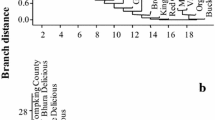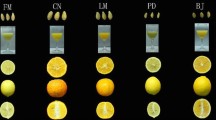Abstract
This study was conducted to determine the yield and physicochemical properties as well as the phenolic compounds, organic acids, antioxidant activity, proteins, and sugars in fresh and dried fruit samples of ‘Carmen’, ‘Etrusca’, ‘Santa Maria’, and ‘Williams’ cultivars, which have an important place in Turkish pear cultivation. Yields of cultivars varied between 12.28 and 23.09 kg/tree, while firmness varied between 4.45 and 9.42 kg, the number of seeds between 7.10 and 9.37 pieces, the amount of soluble solids between 12.22 and 13.40%, the fruit juice pH value between 3.51 and 7.01 and titratable acidity between 0.17 and 0.34%. Chlorogenic acid was found to be the primary phenolic compound in fresh and dried fruit samples, followed by syringic acid. The amount of chlorogenic acid was between 191.56 and 286.58 mg/100 g in fresh fruit samples and between 286.29 and 376.41 mg/100 g in dried fruit samples. It was determined that dried fruit samples had higher phenolic content than fresh fruit samples. The primary organic acid in the fresh and dried fruit samples was malic acid, followed by succinic acid, citric acid, tartaric acid, and fumaric acid. The amount of malic acid was determined between 2213.26 and 34.35.33 mg/100 g and 3070.84 and 5352.79 mg/100 g in fresh and dried fruit samples, respectively. Fresh fruit samples were found to be relatively low in terms of organic acid content compared to dried fruit samples. Glucose and fructose were dominant in both fresh and dried fruit samples. The amount of glucose was determined as 24.07–58.79 mg/kg in fresh samples and 41.30–127.19 mg/kg in dried samples. Antioxidant activity, protein, and vitamin C were higher in dried fruit samples. The antioxidant content varied between 31.74% and 66.55%, and the amount of vitamin C increased significantly with the drying of the samples. The results revealed that drying is preferable for consuming polyphenol-rich pears in the diet.





Similar content being viewed by others
References
Altaf A, Zhu M, Zhu X, Saeed A, Aleem M, Gull S, Hussain S, Masoom A, Quan M (2020) Study of the drying behavior of solar dryer and proximate analysis of the dried pear (Pyrus communis) and peach (Prunus persica). PAKJAS. https://doi.org/10.21162/PAKJAS/20.821
AOAC (1999) Official methods of analysis, 16th edn. Association of Official Analytical Chemists, Arlington
Benvenuti S, Pellati F, Melegari MA, Bertelli D (2004) Polyphenols, anthocyanins, ascorbic acid, and radical scavenging activity of Rubus, Ribes, and Aronia. J Food Science 69(3):FCT164–FCT169. https://doi.org/10.1111/j.1365-2621.2004.tb13352.x
Bevilacqua AE, Califano AN (1989) Determination of organic acids in dairy products by high performance liquid chromatography. J Food Science 54:1076–1079. https://doi.org/10.1111/j.1365-2621.1989.tb07948.x
Bhandari B (2015) Handbook of industrial drying. CRC Press, Boca Raton https://doi.org/10.1080/07373937.2014.983704. ISBN 978-1-4665-9665‑8.
Cemeroğlu B, Yemenicioğlu A, Özkan M (2004) Meyve ve sebzelerin bileşimi. Meyve Sebze Işleme Teknol 1:1–188
Chang CH, Lin HY, Chang CY, Liu YC (2006) Comparisons on the antioxidant properties of fresh, freeze-dried and hot-air-dried tomatoes. J Food Eng 77(3):478–485
Chen J, Wang Z, Wu J, Wang Q, Hu X (2007) Chemical compositional characterization of eight pear cultivars grown in China. Food Chem 104(1):268–275. https://doi.org/10.1016/j.foodchem.2006.11.038
Chong CH, Law CL, Figiel A, Wojdylo A, Oziemblowski M (2013) Colour, phenolic content and antioxidant capacity of some fruits dehydrated by a combination of different methods. Food Chem 141:3889–3896
Colaric M, Stampar F, Solar A, Hudina M (2006) Influence of branch bending on sugar, organic acid and phenolic content in fruits of ‘Williams’ pears (Pyrus communis L.). J Sci Food Agric 86(14):2463–2467
Delgado T, Ramalhosa E, Pereira JA, Casal S (2018) Organic acid profile of chestnut (Castanea sativa Mill.) as affected by hot air convective drying: Drying influence on chestnut organic acids. Int J Food Prop 21(1):557–565
Denizli Directorate of Agriculture and Forestry. (2022). Toprak Haritaları. T.R. Ministry of Agriculture and Forestry. https://denizli.tarimorman.gov.tr/Menu/16/Toprak-Haritalari. Accessed 23 July 2022
Domínguez-Niño A, Salgado-Sandoval O, López-Vidaña EC, César-Munguía AL, Pilatowsky-Figueroa I, García-Valladares O (2021) Influence of process variables on the drying kinetics and color properties of pear slices (Pyrus communis). Color Res Appl 46(5):1128–1141
Dorta E, Lobo MG, González M (2012) Using drying treatments to stabilise mango peel and seed: effect on antioxidant activity. LWT Food Sci Technol 45(2):261–268
Ekici İ, Yıldırım AN (2017) Determination of (Pyrus pyrifolia) morphological, phenological, pomological and some biochemical properties of asian pear cultivars in Uşak ecological conditions. J Suleyman Demirel Univ Inst Sci Technol 21(1):118–124. https://doi.org/10.19113/sdufbed.15491
Etienne A, Génard M, Lobit P, Mbeguié-A-Mbéguié D, Bugaud C (2013) What controls fleshy fruit acidity? A review of malate and citrate accumulation in fruit cells. J Exp Bot 64(6):1451–1469
FAO (2022) Report of FAO on the harvested area and yield of pear. http://www.fao.org/faostat. Accessed 17 May 2022
Fu L, Yang J, Shang H, Song J (2021) Changes of characteristic sugar, fatty acid, organic acid and amino acid in jujubes at different dry mature stages. J Food Compos Analysis 104:104104
Gao QH, Wu CS, Wang M, Xu BN, Du LJ (2012) Effect of drying of jujubes (Ziziphus jujuba Mill.) on the contents of sugars, organic acids, α‑tocopherol, β‑carotene, and phenolic compounds. J Agric Food Chem 60(38):9642–9648
Gebczynski P, Skoczeń-Słupska R, Kur K (2017) Effect of storage on the content of selected antioxidants and quality atributes in convection and freeze-dried pears (Pyrus communis L.). Italian J Food Sci. https://doi.org/10.14674/IJFS-697
Guiné RPF, Barroca MJ, Gonçalves FJ, Alves M, Oliveira S, Correia PMR (2015) Effect of drying on total phenolic compounds, antioxidant activity, and kinetics decay in pears. Int J Fruit Sci 15:173–186
Hudina M, Štampar F (2005) The correlation of the pear (Pyrus communis L.) cv. ‘Williams’ yield quality to the foliar nutrition and water regime. Acta Agric Slovenica 85(2):179–185
Hussain SZ, Naseer B, Qadri T, Fatima T, Bhat TA (2021) Pear (pyrus communis)-morphology, taxonomy, composition and health benefits. In: Fruits grown in highland regions of the himalayas. Springer, Cham, pp 35–48 https://doi.org/10.1007/978-3-030-75502-7_3
Igwilo IO, Iwualla LC, Igwilo SN, Agbara AC, Okpala CO, Ezeigwe CO (2018) Proximate analysis and phytochemical composition of fresh and dried fruit of Morinda Lucida. Biosci J 6(1):31–39
Isabelle M, Lee BL, Lim MT, Koh WP, Huang D, Ong CN (2010) Antioxidant activity and profiles of common fruits in Singapore. Food Chem 123:77–84. https://doi.org/10.1016/j.foodchem.2010.04.002
Izli N, Yıldız G, Ünal H, Işık E, Uylaşer V (2014) Effect of different drying methods on drying characteristics, colour, total phenolic content and antioxidant capacity of Goldenberry (Physalis peruviana L.). Int J Food Sci Technol 49(1):9–17
Karaçalı İ (2009) Bahçe Ürünlerinin Muhafaza ve Pazarlanması. Ege Üniversitesi Ziraat Fakültesi Yayınları, No: 494. Ege Üniversitesi Basımevi, İzmir, p 472
Kivrak I, Duru ME, Öztürk M, Mercan N, Harmandar M, Topçu G (2009) Antioxidant, anticholinesterase and antimicrobial constituents from the essential oil and ethanol extract of Salvia potentillifolia. Food Chem 116(2):470–479
Kolniak-Ostek J (2016) Chemical composition and antioxidant capacity of different anatomical parts of pear (Pyrus communis L.). Food Chem 203:491–497. https://doi.org/10.1016/j.foodchem.2016.02.103
Kumaran A, Karunakaran RJ (2007) In vitro antioxidant activities of methanol extracts of five Phyllanthus species from India. LWT Food Sci Technol 40(2):344–352. https://doi.org/10.1016/j.lwt.2005.09.011
Li X, Wang T, Zhou B, Gao W, Cao J, Huang L (2014) Chemical composition and antioxidant and anti-inflammatory potential of peels and flesh from 10 different pear varieties (Pyrus spp.). Food Chem 152:531–538. https://doi.org/10.1016/j.foodchem.2013.12.010
Lutz M, Hernández J, Henríquez C (2015) Phenolic content and antioxidant capacity in fresh and dry fruits and vegetables grown in Chile. CyTA J Food 13(4):541–547
Macedo LL, Vimercati WC, da Silva AC, Saraiva SH, Teixeira LJQ (2020) Effect of drying air temperature on drying kinetics and physicochemical characteristics of dried banana. J Food Process Eng 43(9):e13451
Marfil PHM, Santos EM, Telis VRN (2008) Ascorbic acid degradation kinetics in tomatoes at different drying conditions. LWT Food Sci Technol 41(9):1642–1647
Melgarejo P, Salazar DM, Artes F (2000) Organic acids and sugars composition of harvested pomegranate fruits. Eur Food Res Technol 211(3):185–190. https://doi.org/10.1007/s002170050021
Morgan J (2015) The book of pears: the definitive history and guide to over 500 varieties. Chelsea Green Publishing
Nazir N, Nisar S, Mubarek S, Khalil A, Javeed K, Banerjee S, Kour J, Nayik GA (2020) Pear. In: Nayik GA, Gull A (eds) Antioxidants in fruits: properties and health benefits. Springer, Berlin Heidelberg https://doi.org/10.1007/978-981-15-7285-2_22
Nour V, Trandafr I, Ionica ME (2010) Compositional characteristics of fruits of several apple (Malus domestica Borkh.) cultivars. Natulae Bot Horti Agrobot Cluj Napoca 39(3):228–233. https://doi.org/10.15835/nbha3834762
Rodríguez-Delgado MA, Malovaná S, Pérez JP, Borges T, García Montelongo FJ (2001) Separation of phenolic compounds by high-performance liquid chromatography with absorbance and fluorimetric detection. J Chromatogr A 912(2):249-257. https://doi.org/10.1016/S0021-9673(01)00598-2
Santos PHS, Silva MA (2008) Retention of vitamin C in drying processes of fruits and vegetables—A review. Dry Technol 26(12):1421–1437
Santos SCRVL, Guine RPF, Barros A (2014) Effect of drying temperatures on the phenolic composition and antioxidant activity of pears of Rocha variety (Pyrus communis L.). Food Meas 8:105–112
da Silva DI, Nogueira GD, Duzzioni AG, Barrozo MA (2013) Changes of antioxidant constituents in pineapple (Ananas comosus) residue during drying process. Ind Crops Prod 50:557–562
da Silva GJ, Villa F, Grimaldi F, Da Silva PS, Welter JF (2018) Pear (Pyrus spp.) breeding. In: Al-Khayri JM et al (ed) Advances in Plant Breeding Strategies: Fruits. Springer, Cham, pp 131–163
Topuz CF, Bakkalbaşı E, Aldemir A, Javidipour I (2022) Drying kinetics and quality properties of Mellaki (Pyrus communis L.) pear slices dried in a novel vacuum-combined infrared oven. J Food Process Preserv. https://doi.org/10.1111/jfpp.16866
Triantis T, Stelakis A, Dimotikali D, Papadopoulos K (2005) Investigations on the antioxidant activity of fruit and vegetable aqueous extracts on superoxide radical anion using chemiluminescence techniques. Anal Chim Acta 536(1–2):101–105
Tülek Y, Demiray E (2014) Effect of hot air drying and different pretreatments on color and drying characteristics of persimmons. J Agric Sci 20(1):27–37. https://doi.org/10.15832/tbd.11768
Wickham, H. (2016). ggplot2: Elegant Graphics for Data Analysis. 2nd ed. Springer. https://doi.org/10.1007/978-3-319-24277-4
Wu J, Fan J, Li Q, Jia L, Xu L, Wu X, Yin H (2022) Variation of organic acids in mature fruits of 193 pear (Pyrus spp.) cultivars. J Food Compos Anal 109:104483
Yi J, Zhou L, Bi J, Chen Q, Liu X, Wu X (2016) Impacts of pre-drying methods on physicochemical characteristics, Color, Texture, volume ratio, microstructure and rehydration of explosion puffing dried pear chips. J Food Process Preserv 40(5):863–873. https://doi.org/10.1111/JFPP.12664
Zou K, Teng J, Huang L, Dai X, Wei B (2013) Effect of osmotic pretreatment on quality of mango chips by explosion puffing drying. LWT Food Sci Technol 51:253–259. https://doi.org/10.1016/j.lwt.2012.11.005
Funding
The authors did not receive support from any organization for the submitted work.
Author information
Authors and Affiliations
Contributions
Levent Kirca and Ahmet Aygün conceived the research. Levent Kirca and Semanur Kirca collected samples and performed the review. Levent Kirca, Semanur Kirca and Ahmet Aygün analysed data. Levent Kirca and Ahmet Aygün wrote the manuscript. All authors read and approved the manuscript.
Corresponding author
Ethics declarations
Conflict of interest
L. Kırca, S. Kırca, and A. Aygün declare that they have no competing interests.
Rights and permissions
Springer Nature oder sein Lizenzgeber hält die ausschließlichen Nutzungsrechte an diesem Artikel kraft eines Verlagsvertrags mit dem/den Autor*in(nen) oder anderen Rechteinhaber*in(nen); die Selbstarchivierung der akzeptierten Manuskriptversion dieses Artikels durch Autor*in(nen) unterliegt ausschließlich den Bedingungen dieses Verlagsvertrags und dem geltenden Recht.
About this article
Cite this article
Kırca, L., Kırca, S. & Aygün, A. Organic Acid, Phenolic Compound and Antioxidant Contents of Fresh and Dried Fruits of Pear (Pyrus Communis L.) Cultivars. Erwerbs-Obstbau 65, 677–691 (2023). https://doi.org/10.1007/s10341-022-00760-0
Received:
Accepted:
Published:
Issue Date:
DOI: https://doi.org/10.1007/s10341-022-00760-0




